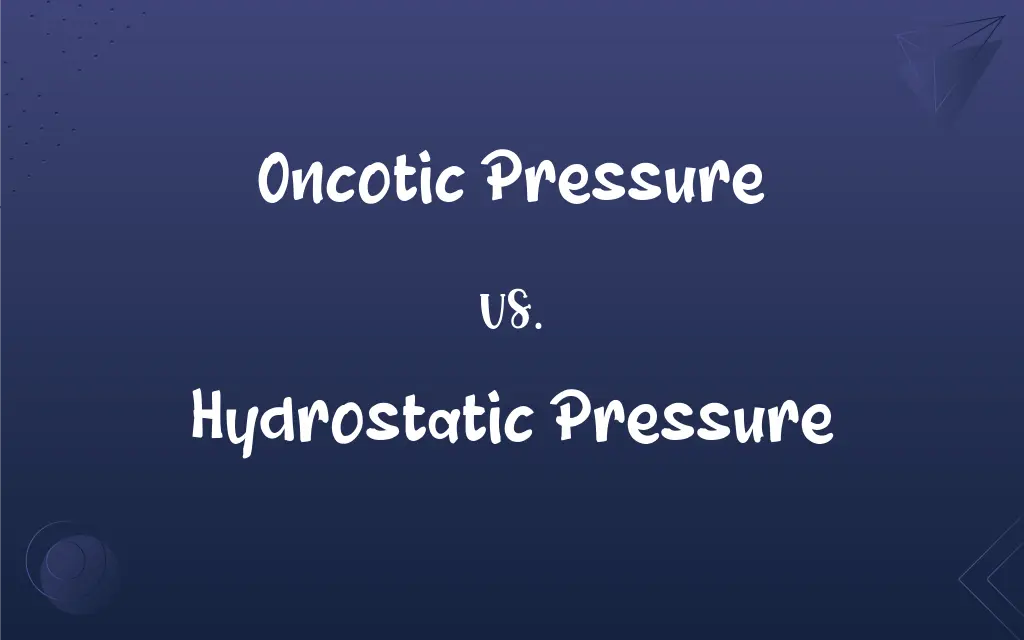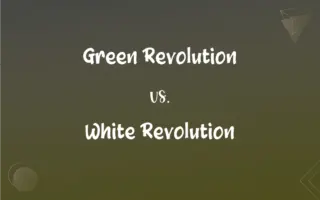Oncotic Pressure vs. Hydrostatic Pressure: What's the Difference?
Edited by Aimie Carlson || By Janet White || Published on February 23, 2024
Oncotic pressure is the osmotic pressure due to proteins in blood plasma, while hydrostatic pressure is the force exerted by fluid in blood vessels.

Key Differences
Oncotic pressure is generated by plasma proteins, particularly albumin, and is crucial in maintaining fluid balance in the circulatory system. Hydrostatic pressure, on the other hand, is the pressure exerted by the fluid inside blood vessels, driving fluid out of the vasculature.
Oncotic pressure works to draw fluid into the blood vessels, countering fluid loss. In contrast, hydrostatic pressure tends to push fluid out of the vessels, especially in capillaries, influencing filtration and fluid distribution.
Abnormalities in oncotic pressure, often due to low protein levels, can lead to edema as fluid accumulates in tissues. Elevated hydrostatic pressure, often seen in hypertension, can strain blood vessels and affect organ function.
Diseases that lower plasma protein levels, like liver failure, can reduce oncotic pressure, disrupting fluid balance. Hydrostatic pressure is directly influenced by heart function and vascular resistance, playing a key role in cardiovascular diseases.
Oncotic pressure is typically measured indirectly via protein concentrations in blood tests. Hydrostatic pressure, however, is directly measurable as blood pressure, a vital sign in clinical assessments.
ADVERTISEMENT
Comparison Chart
Source
Generated by plasma proteins
Exerted by fluid in blood vessels
Primary Role
Draws fluid into blood vessels
Pushes fluid out of blood vessels
Influence on Edema
Low oncotic pressure can lead to fluid accumulation
High hydrostatic pressure can contribute to edema
Measurement
Indirectly via protein levels
Directly as blood pressure
Related Diseases
Linked to conditions like liver failure
Associated with hypertension and heart conditions
ADVERTISEMENT
Effect on Blood Flow
Affects fluid retention in vessels
Influences filtration and distribution of bodily fluids
Oncotic Pressure and Hydrostatic Pressure Definitions
Oncotic Pressure
Counterbalances hydrostatic pressure in capillaries.
Oncotic pressure prevents excessive fluid loss from blood vessels.
Hydrostatic Pressure
Integral in fluid filtration and distribution.
Kidney function depends on the hydrostatic pressure in glomeruli.
Oncotic Pressure
Pressure exerted by proteins in blood plasma.
Reduced oncotic pressure in malnutrition can cause swelling in the legs.
Hydrostatic Pressure
Pressure exerted by fluid in blood vessels.
Elevated hydrostatic pressure can strain the heart and arteries.
Oncotic Pressure
A form of osmotic pressure in blood vessels.
Oncotic pressure helps maintain fluid balance in the circulatory system.
Hydrostatic Pressure
Directly measurable as blood pressure.
Hypertension is a condition of sustained high hydrostatic pressure.
Oncotic Pressure
Influenced by plasma protein concentration.
Albumin infusions are used to increase oncotic pressure in critical patients.
Hydrostatic Pressure
Drives fluid out of blood vessels.
High hydrostatic pressure in capillaries can lead to swelling.
Oncotic Pressure
Vital in preventing edema.
Low oncotic pressure can lead to fluid accumulation in tissues.
Hydrostatic Pressure
Influenced by blood volume and vessel resistance.
Hydrostatic pressure increases with higher blood volume.
FAQs
What does hydrostatic pressure do?
It exerts force by fluid in blood vessels, influencing fluid flow.
What causes low oncotic pressure?
Low protein levels, often due to liver or kidney disease, can cause it.
Can hydrostatic pressure affect organ function?
Yes, particularly in conditions like hypertension.
Can dehydration affect these pressures?
Yes, it can decrease both oncotic and hydrostatic pressures.
Do these pressures interact?
Yes, they work together to regulate fluid distribution in the body.
What role does oncotic pressure play in edema?
Low oncotic pressure can lead to fluid accumulation in tissues.
What increases oncotic pressure?
Higher plasma protein levels, especially albumin, increase it.
How are these pressures measured?
Oncotic pressure is measured indirectly via protein levels; hydrostatic pressure is measured as blood pressure.
What is oncotic pressure?
It's the osmotic pressure due to plasma proteins in blood.
How does hydrostatic pressure contribute to edema?
High hydrostatic pressure can force fluid out of vessels into tissues.
What factors raise hydrostatic pressure?
Increased blood volume or vessel resistance can raise it.
Does age affect hydrostatic pressure?
Yes, it often increases with age due to vessel stiffness.
How does kidney function relate to these pressures?
Kidneys regulate both by managing fluid and protein levels.
What impact does nutrition have on oncotic pressure?
Adequate protein intake is crucial for maintaining normal oncotic pressure.
Is oncotic pressure important in fluid therapy?
Yes, especially in managing fluid balance in critical care.
Does posture affect hydrostatic pressure?
Yes, it's generally higher in the feet and legs when standing.
Is oncotic pressure a constant value?
No, it varies with protein levels and health conditions.
Can heart health influence hydrostatic pressure?
Yes, heart function directly impacts hydrostatic pressure.
How do diseases like liver failure affect oncotic pressure?
They can lower it by reducing protein synthesis.
Can exercise influence hydrostatic pressure?
Yes, it temporarily increases during physical activity.
About Author
Written by
Janet WhiteJanet White has been an esteemed writer and blogger for Difference Wiki. Holding a Master's degree in Science and Medical Journalism from the prestigious Boston University, she has consistently demonstrated her expertise and passion for her field. When she's not immersed in her work, Janet relishes her time exercising, delving into a good book, and cherishing moments with friends and family.
Edited by
Aimie CarlsonAimie Carlson, holding a master's degree in English literature, is a fervent English language enthusiast. She lends her writing talents to Difference Wiki, a prominent website that specializes in comparisons, offering readers insightful analyses that both captivate and inform.







































































